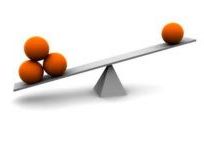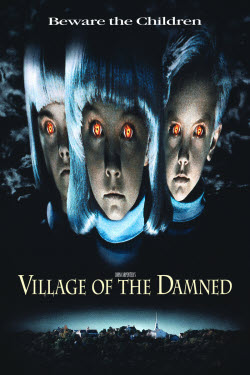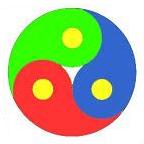(New Instrument of Threes)
- page nine-
(The Study of Threes)
http://threesology.org

Whereas an actual pattern-of-three are like a symmetrically balanced triangle, as might be symbolically related with the words Monism - Dualism - Pluralism; to make a third out of a "two" such as a dualism/dichotomy, is a portrait of lopsidedness when it is seen from the outside of a dichotomy that has been in one way or another, proportioned into three separate references.
For example, a man and wife can be viewed to be in conflict or a balanced complement. Upon the birth of a child, this situation may be viewed as a balanced complement or unbalanced conflict. They are nonetheless a singular unit of three. They are not separate just as dichotomies are not separate. The three, in this instance, are as a single weight which is unbalanced from other singular considerations such as the addition of another child, a job, an injury, etc... Though such additions may later become considered a part of the unit and can produce an unbalanced circumstance during a loss or departure.
The balancing act is an artificiality when placed into a larger context. For example. Let say you live in a dichotomous world view. Everything you interpret is based on some measurable or even unmeasured dichotomy. Whereas you are aware of Monotomies and Pluralities, you view these in dichotomous fashions such as a Monism - Dichotomy dualism set, or a Monism - Pluralism dualism set. And even though you make mention of a three-part Monism - Dualism - Pluralism set, you still arrange this three- structure into a two-part structure. And you may not even be aware of doing it... because you don't know how to think in terms of "three"...
...And neither do any of your friends, colleagues, or instructors. It's not even in any literature except in the form of some superstition (such as calling it a "magic" number) or aligned with some childish religious perspective which is based on the primitive dichotomy of good and evil. Whereas these two selections can be viewed as examples of past ideas perpetuated into the present, examples of the present would be to cite the number in such things as a triadic music structure, a triplet coding system in DNA, and various other "modern" day uses thereof. But in terms of attempting to describe it in some future term, we refer to some metaphysic because it is at present (thought to be) unknown but (is) not necessarily unknowable.
We may or may not even have a word for it, in any present day vocabulary. No present day language may even have a means of describing it since our present languages are little more than primate grunts like an Orangutan, Chimpanzee or even Australopithecine trying to use its vocabulary to describe quantum physics, germ theory, or some concept such as (a) God or Goddess.

Then again, perhaps there are examples of future humans in our midst but our present cultures do not permit them to thrive like the children in the movie "The Village of the Damned", though other movies describe similar rejections of individuals or groups because of exhibiting different intellectual (mental) behavior illustrated by non-usual behavior... though minority groups in the present might consider attempting to compare themselves with such when in fact there is no comparison to be made such as in the case of cannibalism, homosexuality, incest, murder, pedophilia, rape, etc... In other words, there is no greater intellect behind their self-centered assertions for thinking differently than most others. To permit such individuals to become the dominant perspective is permitting them to create a society of the damned. The only "emergent" mental property to denote is an expansion of a collective nonsense. Take away human sexuality form the relationship equation and many of those now involved with one another would dramatically change their lifestyles. A society based primarily on sexuality is a village of the damned... and they are oblivious to this. It is indeed difficult to describe to a herd that it is running towards a cliff when all the authoritative stallions are directing them to follow suit.
It should be considered that numerous people are viewing this "three" image as a metaphysic for which there are various allusion thereto but they are occurring in different subject areas with different labels and no one is collecting and collating them under a single heading. In an attempt to divest the "three" of its indistinct "shadowiness" (or whatever label you are using for the moment), we need to claim that it is not a figure seen in the clouds for which others are being asked to contour their brains in order to see the same figure which eventually whispers away into some other form directed by imagination.
Many of us can see hints of it described in various patterns-of-three. But the three is only a description, a symbol, a form that not only does our mind become impressed upon with, but so has our genetics and physiology. The "three" may only be a convenient label. Many of us see something and we illustrate it with a "three" pattern, but such a description may be a child's finger painting exercise. In most cases, people reference the "three" in some superstitious, religious or urban legend (i.e. "death occurs in threes") fashion. They honestly do not know how to think in threes. There clearly is a veil over our eyes and this veil may be an indication of a poor language, poor vocabulary, culturally imposed limiting mindset, primivity of brain development, lousy nutrition, bad genetics, or the Earth's environment needs to change more in order to influence us better.

And neither is the "three" the product of a dichotomy that is partialized or proportioned in one manner or another such as that applied in computers or other subject areas such as sales and marketing, with the adoption of a Boolean logic. Whereas the "three" is a familiar enumeration, this reference may be wholly inappropriate to the topic of the present discussion, but for want of a better word, symbol or description, it enables multiple lines of familiarity to be used. The "three" perspective in these terms of reference makes the phenomena artificial. I'm not saying they aren't real to the perceiver, but they are artificial because they are expressions of poorly defined and illustrated impressions not only about what is generating the recurrence of many different references thereto, but in enabling us to better grasp a clearer reality thereof. It is being illusive like harboring its own uncertainty principle.
The artificiality of balance, of harmony, of happiness, of peace, etc., is noted when it becomes destabilized by any number of occurrences... some foreseeable, while others are not as easily predicted. But if one only measures values within the context, it is like wearing blinders, as is the case with some religious or other social beliefs espoused in songs, movies, stories, political policies, education, etc., it can very well be interpreted to be in an acceptable state of (at least sought after) balance, harmony or happiness... or even some representative model of excellence. This is what is taking place with the binary code being used in computers to improve functionality. Boolean logic only gives the appearance of being more than the underlying dichotomy, which is a view suppressed by the language(s) being employed, like a religious belief.

When speaking of the "three", I'm not trying to describe an emergent property which proceeds from a usage of some former idea, but the existence of that with a separate identity that the present state of the human mind can vaguely apprehend, but has no pre-existing formula for making a coherent comparison to and thus remains as an image inter-mixed with all the so-called "relevant" ideas in use in our present cultures within the outlines of one's language and vocabulary. It's not that one's vocabulary may be unable to describe the impression(s) in a fundamental and accurate way for others to establish a working model that their own images might well be attached to for greater reflection and discernment for increasing comprehensibility it's just that established culturally-imposed rules of expression and thought encourage and force people to render their impressions into a ghost-like continuance. Businesses, governments and religions want you to perceive the world in their way in order to make their own existence that more viable. To think differently is to be interpreted as a threat or potential threat.
In such a view, all of us can be assumed to live partly in another world that exists not as an epiphenomenon (emergent property), but as a phenomenon that is possible but does not yet exist culturally aside from this presumed internal schema mulling around in our brains and trying to find some means of fulfilled expression that some might contend is an unrealized collective feature of our personality that is suppressed by all cultures. Whereas the word "personality" is used as a metaphor, it is not to be interpreted to suggest the suppression of instinctual or basic "animal" drives without being tethered to any social mores such as descriptive morality.
We could say that which is suppressed is a new way of thinking, a new way of perceiving in terms of interpretation, and thus is a new way of life. As such, it could exist in a fully expressed functional state, but we would have to set aside many, most, or all of our current ideas in terms of how they are now thought of and expressed. For example, we may describe existence as due to a God, but our misinterpretation is illustrated by our description which also perpetuates the same sorts of belief structures about existence. The usage of a different term, through-out our world cultures, might help to make the assumed underlying image a realized manifestation. To call this underlying (below ground level) stream of thought an idea, a thought a musing, a notion, a consideration, or some other similar existing form, might well do it and us an injustice because such labels typically are dismissive and replaced with "whole" ideas currently in vogue as practiced by one's culture and used by existing institutions such as religion or philosophy or psychology as if they are suppositions already looked at and placed into their own respective drawer of curios.
To use but one example of a dichotomy from the above list and because it was implied (tentatively used) previously when discussing Francis Bacon on the 1st page in this discussion section; Rationalism and Empiricism can provide us with a model of further exploration, inasmuch as both have proponents and antagonists. However, one could slightly alter the "Rationalism and Empiricism" profile to be read as "Rationalism and Imperialism" since the "rationale" of politicians is to claim to have "experience" as a rite-of-way exercise to maintain control over the lowly public and to keep it from having a fully recognized and fully functionalized process of Referendum whose process and policy is also controlled by the people and is not at the whim of politicians who think they have the "experience" to best determine how, when, where and why the Referendum should be carried out... and not just when they want to use it as a last resort or last ditch effort to get things their way... which is to revert the process of Referendum whenever they want to so that it might serve as a personalize tool of convenience.
Whereas some prefer Rationalism over Empiricism or the latter over the former, others presumptively think they are superior if they combine the two together; which is highly reminiscent of the old Alchemical predisposition to mix substances together and if it smells good or bad, to likewise label the combination as good or bad... particularly when one's ego gets involved in the method of processing. But even though old systems of Alchemical processing may have used a numerical-based means of indicating how much (or little) of a substance a certain concoction was made, such as gunpowder with a three-part ratio containing potassium nitrate (75%), charcoal (15%), and sulfur (10%); the substitution of words for numerical quantities is not typically considered when describing a history of the human "psychological system".
Indeed, while Monisms, Dualisms (dichotomies) and Pluraliisms (many) are discussed, and even though many readers might alternatively see these as representative numerical quantities; such a one - two - many (page a) pattern is not seen as a pattern-of-three and then also associated with the larger body of "threes" examples... from which originates contemplations of an existing psychological system not being addressed by current philosophy or psychology outside current systems of correlation such as being related to religious, superstitious or some pseudo- science or philosophy such as, for example, numerology.
In further words, we need to look a bit more closely at this ancient way of influencing the processing of information, even though this typically leaves off an exploration into the possible origin of how dichotomous thinking may have arisen in the first place.
On the other hand, if we were to establish that the Dichotomization of ideas was influenced by simple environmental circumstances such as the events of night/day, hot/cold (summer/winter), high/low, far/near, large/small, etc., and/or are biologically based: male/female, child/adult, young/old, empty stomach/full stomach, etc., we might want to also try to establish whether (and which) events influenced purely biological ones such as the male/female sex divisioning, two eyes, two ears, etc... Also, is the exponential divisioning and multiplication of sex cells just a multiplistic doubling? Are we thus to say that dichotomous thinking is innate and is primarily the reason we perceive and utilize patterns-of-two, whether in a contentious or complement form? And then what do we make of a triplet coding in DNA on this third planet? And would it have made a difference if we were on the 2nd planet in this solar system if it could sustain life?
Despite these by the wayside questions, I think it is necessary and highly desirable to ask some other questions in order to grasp the implications of the established (two-patterned) parameters to such a process that is often used as a "reason" (excuse) to foment acceptance of the idea regarding the notion of a superior idea having been achieved when an idea is presented as being the result of an alloy of a dichotomy. Simply put, some people think that they have come up with a superior idea when they have take two opposing ideas and meshed them together in one or another fashion:
- Where/when (time and place) humans came up with the idea that a compromise is a superior (mental) pre-disposition?
- Why (specific to a time and place) humans came up with the idea that a compromise is a superior (mental) pre-disposition?
- Who/which humans came up with the idea that a compromise is a super (mental) pre-disposition (such as were they old, young, male, female, black, white, Asiatic, pre-Homo sapiens sapiens)?
...And accordingly, when did such a perspective become considered to be a third way of thinking? Simply because we take two and mesh them together— why do we, in certain instances, automatically come up with the notion of a third being generated and not some enumerated proportion such as occurs with the usage of a Dewey Decimal system when adding another book to a collection? The idea of a "third" perspective being generated out of two, irrespective of what proportion of the two is used, can give the impression of striving for some balance. As such, the equation of 1 + 1 = 3 is falsely aligned as a symbolic representation. In other words, it's a mistake in thinking to try to apply mathematics to that which can not be simplistically rendered with basic arithmetic requiring a differently "appendaged-with" logic of accountability. And I say this not as a means to provide anyone with the notion that it is therefore something greater than mathematics, but that the type of equation with its basic one -to- one association is inappropriate.

For example, some have it in their mind that combining an embodied proportion of Yin and Yang will produce a balance. But then these same adherents to this philosophy want you to also believe that achieving this harmony of balance is not always easy. Hence, it's the old bait and switch routine used by all religions that say you can achieve peace and salvation if you believe in a certain way, and then create circumstances or ideas which create conflict and obstacles; whereby you will seek out guidance by a presumed "professional" who professes to know more than they actually do, yet manipulates you into assisting them in their survival by way of giving money sometimes called tithing.
The Yin - Unity - Yang philosophy while appearing to present a third position by way of a harmonic balance is in fact presenting a pattern-of-two with the Yin/Yang as a 2 in 1 singularity, but it is presented as a to-strive-for desirable 3 in 1 whole, like the doctrine of the Christian Trinity with its 3 persons (or aspects) in one entity. The idea of a third perspective having been achieved is a metaphysic and represents the same underlying mental pattern taking place in other subject areas. The presented idea of a THIRD being achieved by way of two being proportioned together, is a desire for a third, but it is not actually a third having been achieved as represented by the following two images:
 |
This same idea of a third having been achieved from a "set" of dichotomies in that the opposite of one idea is considered as a contrast:
- Like artists attempt in their work involving shadow(s) and light(s), up and down, distant and near, etc., in their search to portray either a greater extreme of a (believed to have been achieved) perspective suggestive of a centrality, a happy medium, a consolidation, a harmony, a balance, etc.,... by using a three- dimensional perspective, three-color code, etc.
- Like musicians attempt to portray some note or tune existing somewhere between (or at the extreme of) major and minor (chord) variations... perhaps by using musical triads, "Middle" C as a fulcrum, etc...
- Or like mathematicians seeking to convey "the extreme or in-between" by way of achieving some solution, finding discrepancy in another's formulation, etc...
However, it is necessary to point out that while we can find numerous examples of "threes" and as well patterns-of-two that may or may not be called dualisms or dichotomies which are used to present the basis for describing some compromised alternative; neither of these have actually achieved an actual "three". What they actually describe is an image of a three. They are the manifested attempts to describe an impression that is not as yet clear and may not be achieved until some evolutionary change takes place in the human brain, some environmental event influences the realization, or who knows what. As it stands, the "three" as is being portrayed in the very many subject areas and in different ways, which includes by way of dichotomies; may be a metaphor, an intermittent glimpse at the corner of one's eye that is nuanced into a form a person's mind is focused on in their respective interest.
HTML (4.01) update: Monday, June 10, 2019... 4:55 AM
Your Questions, Comments or Additional Information are welcomed:
Herb O. Buckland
herbobuckland@hotmail.com